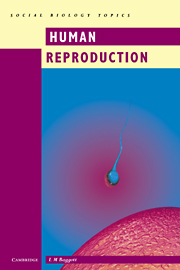Book contents
- Frontmatter
- Contents
- 1 Human reproductive strategies
- 2 Gamete production
- 3 Fertilisation
- 4 Implantation and pregnancy
- 5 Birth and lactation
- 6 Contraception
- 7 Human infertility: background and causes
- 8 Human subfertility: options and treatment
- 9 Ethical and moral considerations of fertility and infertility
- Index
8 - Human subfertility: options and treatment
Published online by Cambridge University Press: 05 June 2012
- Frontmatter
- Contents
- 1 Human reproductive strategies
- 2 Gamete production
- 3 Fertilisation
- 4 Implantation and pregnancy
- 5 Birth and lactation
- 6 Contraception
- 7 Human infertility: background and causes
- 8 Human subfertility: options and treatment
- 9 Ethical and moral considerations of fertility and infertility
- Index
Summary
Problems of subfertility affect both sexes approximately equally. Chapter 7 dealt with initial investigation and diagnosis of both female and male patients, and this chapter will discuss the options and treatment available to the subfertile couple in specialist centres and clinics. Many of the procedures of reproductive technology are surrounded with considerable moral and ethical controversy, and the final chapter of this book, chapter 9, is devoted to a discussion of the main issues.
Relatively speaking, less is known about causes and few remedies are available for problems of male subfertility, though it is the focus of an increasing amount of research. The study of male reproduction is called andrology.
Problems of gamete production
Treatment options for poor sperm quality
Techniques for improvement of sperm quality
Although a few cases of azoospermia (total lack of sperm in the semen) have been treated successfully by administering FSH and/or hCG, very little can be done at present about either azoospermia or asthenospermia (poor sperm quality), and the couple is usually advised to consider donor insemination (see below). Oligospermia (very low sperm concentration) can often be helped by taking general measures to improve health, such as losing weight, stopping smoking, reducing alcohol intake and avoiding stress. Some doctors and medical scientists have tried using various hormones and other chemical substances such as arginine, zinc and vitamin E for treating low sperm count and/or poor sperm quality but with very limited success.
- Type
- Chapter
- Information
- Human Reproduction , pp. 81 - 93Publisher: Cambridge University PressPrint publication year: 1997



